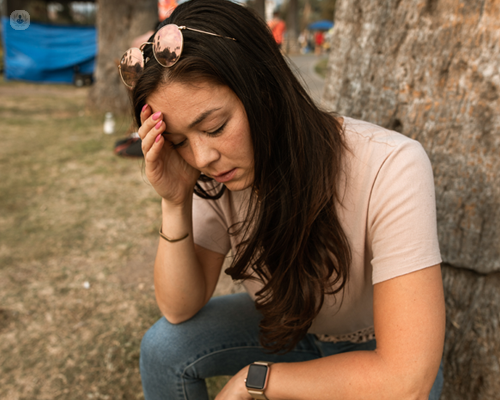Why mental health shouldn't be overlooked in CRPS
Escrito por:Complex regional pain syndrome (CRPS) is a chronic condition that brings about extreme discomfort and can have a significant impact on mental health. It is a condition to be taken seriously, and leading pain management specialist Dr Roshan Thawale tells us why in this comprehensive article.
Find out what it feels like, the three stages of CRPS, and how the mental health aspect of this potentially life-long illness can be overlooked, among other important points.

What is CRPS?
CRPS is complex regional pain syndrome. It's a form of chronic pain that usually affects your arms or legs. In CRPS, the pain typically develops after an injury. Sometimes the injury can be severe or sometimes injury can be seemingly trivial, like a needle or thorn prick.
It can be from:
- surgery;
- a stroke;
- a heart attack.
The one point that needs to be noted here, is that pain is completely out of proportion to the severity of the injury. It does lead to long-term damage.
What does CRPS feel like?
In CRPS there are sets of signs and symptoms which were previously described by the International Association of Study of Pain (IASP). The previous criteria was Budapest criteria, and the current criteria are Valencia criteria.
It usually presents as continuous burning or throbbing pain in the affected area. It can be your leg, arm, or foot. It can be in the chest. There's a profound sensibility to touch and the cold; there's a profound swelling of the region as well, and the region looks red and angry.
There are changes in your skin temperature, too. It can alternate between very sweaty palms to very cold feet. The skin colour can range from angry red to blotchy blue. Classically, the patient always describes them as blotchy blue.
There are changes in your hair and nail structure, as well. Sometimes your nail can be in growing or outgrowing. Sometimes you'll find that the affected region has a change of hair colour, or it becomes shiny, thin, or brittle. There's joint stiffness; swelling; there are changes in the alignment of the joint - sometimes it can look crooked. You can have spasms, tremors, weakness and generalised loss of muscle, which we call atrophy in medical terms. There's a decreased ability to move very far.
First and foremost, the patient can describe that they're not able to wear socks; they're not able to wear stockings; they're not able to wear gloves. This is where our suspicion towards CRPS rises.
Having said that, CRPS needs to be diagnosed by a specialist, and it is a diagnosis of exclusion. It's usually over diagnosed, and I'll say it's over diagnosed as an anomaly, but I would think that as a pain specialist it's neurologists, physiotherapists or orthopaedic surgeons are best placed to diagnose CRPS. They will do it with scientific criteria, and there's aren't many tests to diagnose CRPS. In the research world there's a test called quantitative sensory testing.
What are the three stages of CRPS?
There are various stages of CRPS, starting with the acute stage which lasts for about three months.
Acute stage
During this stage, this is where the patient experiences the burning type of pain. They might mention 'my foot is on fire', 'my hand is on fire'. There's a swelling, there's an immense amount of sweating, and the patient will tell you they're not even able to write on paper, as well, because the sweat is completely dripping on their paper. There's a decreased range of motion.
Subacute stage
Then the gradual progression happens after around three months to something which we call the subacute stage. During this stage, there's a continued serial pain, but a throbbing nature is now more profound. There's a generalised dryness of the skin, and dryness is so severe that skin starts to break off. There's a painless and blotchy discolouration of the skin, as well.
Chronic stage
After 12 months, CRPS develops into a chronic stage. It can last for multiple years, if not decades, or it can become permanent in a few cases. This is where the patient's pain is variable and it has a seasonable variation; it has monthly variations, and has various exacerbating factors to it as well. Skin appears dry, shiny, it's cool to the touch, and sometimes the patient isn't using their extremities at all. They haven't used their hand for a long time together, and those changes can be seen on their muscles. They can be seen as a permanent deformity in their joints. This is where your affected region; the bones are starting to become more brittle. You can actually notice that one of the feet appears much thinner that the other, or hand, for that matter.
Is CRPS a permanent disability?
CPRS can last for a long time. It makes it absolutely impossible for someone to continue in their normal line of work. Anyone can expect that they can be out of work for at least 12 months following the diagnosis of CRPS. Having said that, there are various occupational therapists, who are part of my disciplinary team, that treat CRPS.
The aim of inputting into the multidisciplinary manner is to reduce this permanent disability. But yes, CRPS does have a profound long-lasting effect on the patient.
Can CRPS be fatal?
CRPS usually tends to be non-fatal as such, but it can have a severe mental impact it has on the patient. I've seen patients with suicidal ideation; self-harm can also be an issue; complete loss of social interactions can happen; patients stop taking their regular medications such as blood pressure or diabetic medication, which can then lead to other complications. I would say CRPS, as such, isn't fatal, but it's the sequela, especially in addition to mental health which can lead to fatality.
How is CRPS treated?
Classically, CRPS used to be treated with the four pillars of CRPS. First and foremost, is physical therapy, or physiotherapy. There are various forms of physiotherapy and the aim of this is to prevent long-term disability, to prevent long-term deformity of the patient. They can range from pacing and coping activities, to creating mirror images.
The second part is to have pharmacological therapies. They can range from anti-neuropathic medication which is medication that stops the pain coming from the nerves, to strong painkiller medication, and various medications which prevent osteoporosis which is when bone becomes brittle.
There are various other medications in terms of Vitamin C tablets, which has been advocated by the Royal College of Surgeons. In regards to the progression of CRPS, Vitamin D tablets have been used to help prevent this.
Then we come to the next part of the four pillars which is the pain management. A pain management specialist can suggest ways to reduce pain through pain relief injections: nerve blocks, sympathetic blocks which can range from lumbar sympathetic blocks or a stellate ganglion block which are done at the neck level.
The idea of these blocks is to decrease the sympathetic drive of the pain. There are various other modalities, which are approved by the National Institute of Health and Care Excellence (NICE), which are spinal cord stimulators, dorsal ganglion stimulators, and last but not least, is the surgical input.
Sometimes you may need surgical input to correct the deformity at first, to correct the bony spurs which are leading to the chronic pain. Amputation is also one of the options of CRPS as a last resort.
Finally, there is also the psychological aspect. The impact of CRPS on mental health is significant. It's very important that the patient receives psychological help. They also need to be referred to a liaison psychiatrist because of potential depression, anxiety and avoidance behaviour. All of these can be corrected with CBT, which is cognitive behavioural therapy, or ACT which is acceptance commitment therapy. There are various other mindfulness techniques which help patients regain their mental composure, and this is one of the most neglected aspects of the treatment. However, I think this is the most important aspect of the treatment.
If you're looking for expert CRPS treatment, arrange a consultation with Dr Thawale via his Top Doctors profile.


